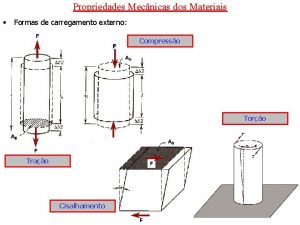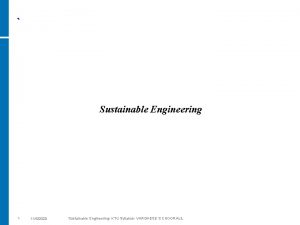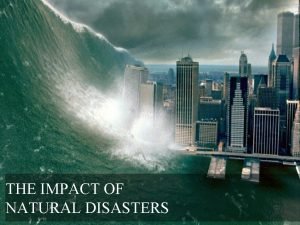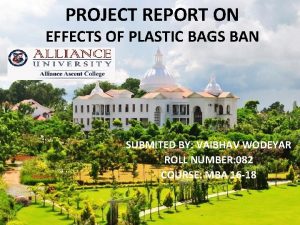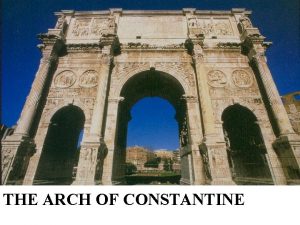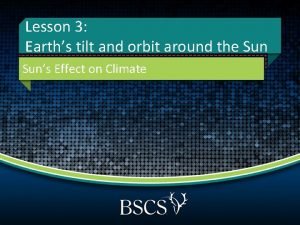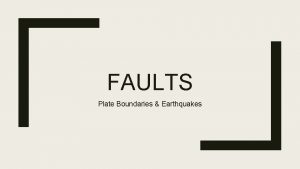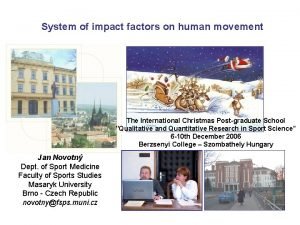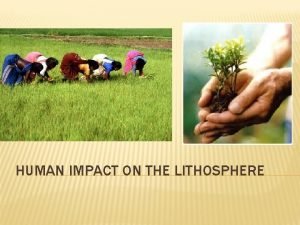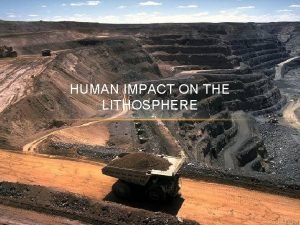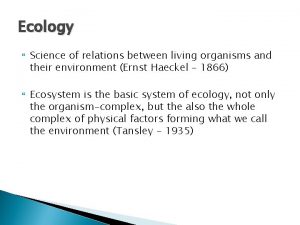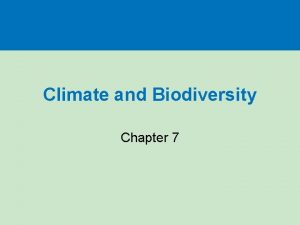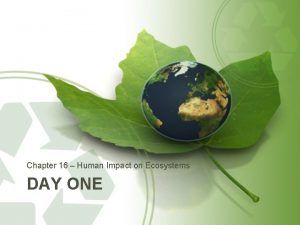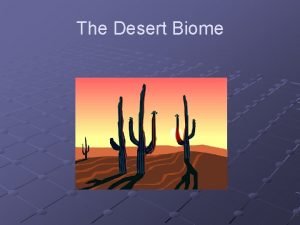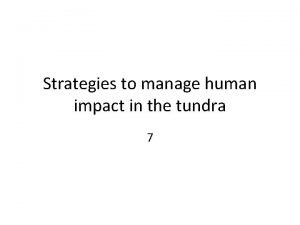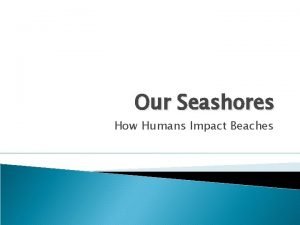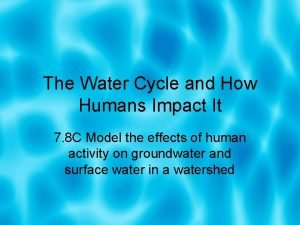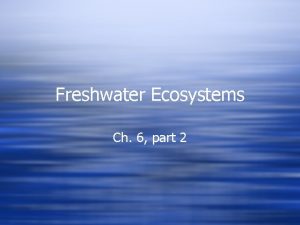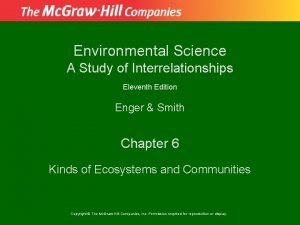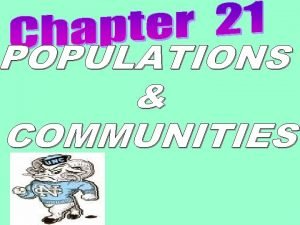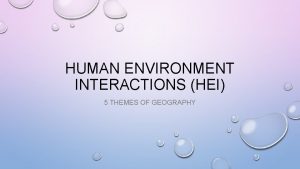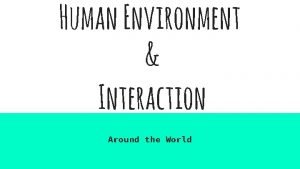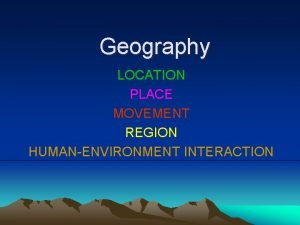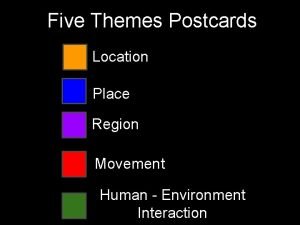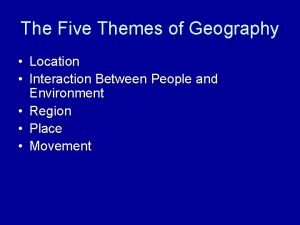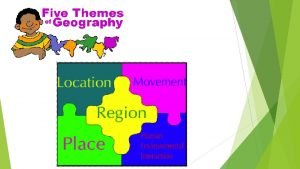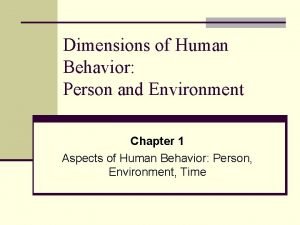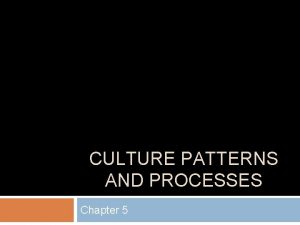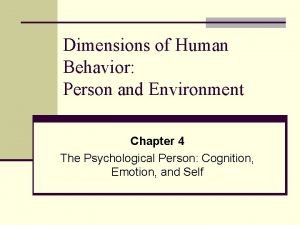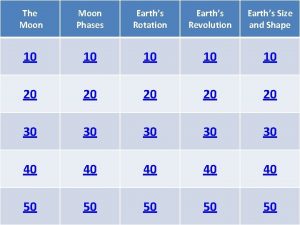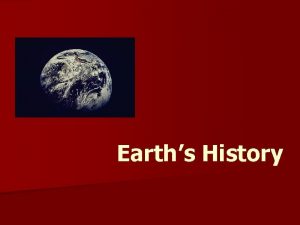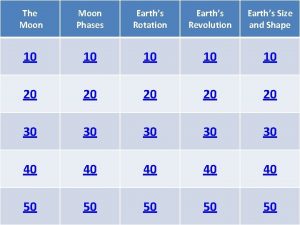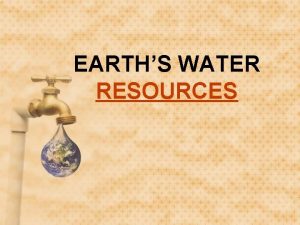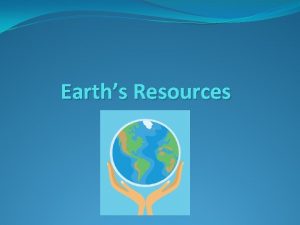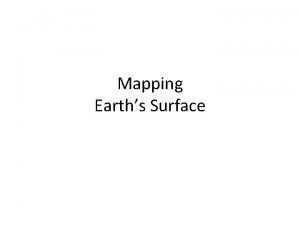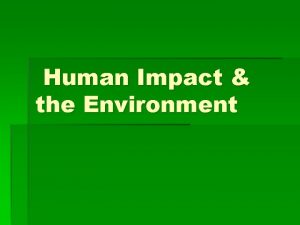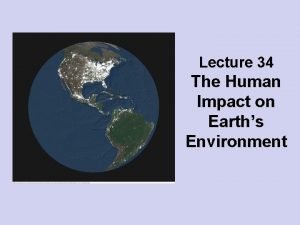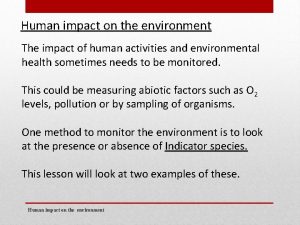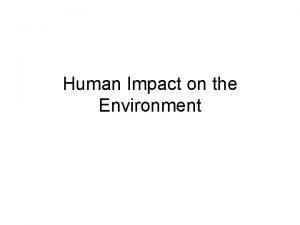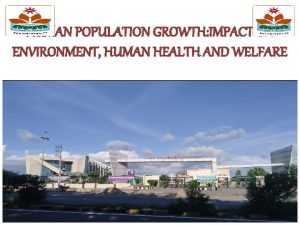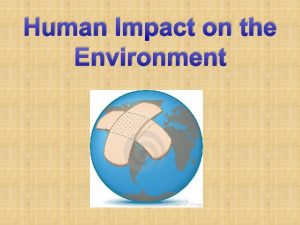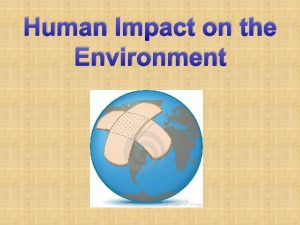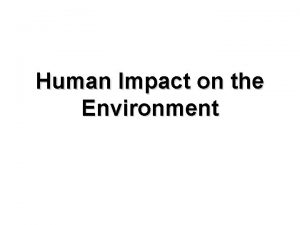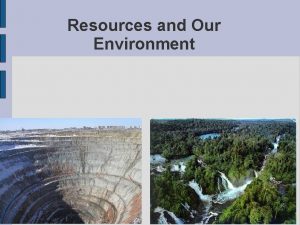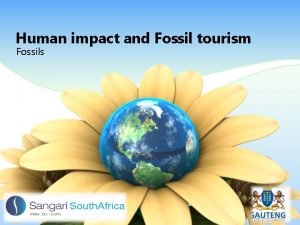Human Impact HI on the Environment Earths Fragil























































































- Slides: 87

Human Impact (HI) on the Environment Earth’s Fragil Biosphere Milton Saier Professor of Molecular Biology University of California, San Diego msaier@ucsd. edu

HUMAN AND EARTH RIGHTS ORGANIZATION (HERO) honors EARTH DAY - EVERY DAY! One people, One biosphere, One Earth, One future. CELEBRATE OUR ENVIRONMENT!

Overpopulation • • • The world's population is now over 7. 7 billion and it is still expanding very rapidly. Every day we share the Earth and its resources with over 200, 000 more people than the day before; every year, there about another 80 million mouths to feed. It is the equivalent of adding all the people in San Diego to the world population every week; The people of Los Angeles every two weeks; Almost all of the people of Mexico every year; And all of the people in North America every three to four years.

Pyramid at Chefren

Mayan Ruins

Easter Island (Rapa Nui)


“Discovered” by the Dutch Explorer Jacob Roggeveen in 1722 CE on Easter Day n n Barren grassland without a single tree or bush over 10 feet high. Around 2000 inhabitants speaking a language of Polynesian origin. Only 47 species of plants (mostly grasses, sedges, and ferns). Native animals included nothing larger than insects. Domestic animals, only chickens.

n Around 300 statues (Moai). n Heights of 33 feet. n Weighing up to 82 tons.


n n Around 700 more in various stages of completion. The largest of these unfinished statues was 65 feet tall and 270 tons.

In the 1960 s the Swiss writer Erich von Däniken claimed they were the work of extraterrestrial astronauts with ultramodern tools, who became stranded on Rapa Nui and were finally rescued.

Archeology n Radio Carbon dates estimate first human arrival around 500 CE, also supported by linguistic research. n Garbage heaps have shown that early Easter Islanders (people of Rapa Nui) subsisted on fish, seabirds, and a large quantity of dolphin.

One Mystery Solved Palms furnished canoes to hunt dolphin. n Palms probably were not used to move statues from the quarries to the coast. n Ropes from the huahua tree enabled islanders to erect and “walk” the massive statues to the coast. n Toromiro trees yielded firewood to cook the fish, seabirds and dolphin. n

Population Densities of archeological sites suggest a large population. n Archeologists put the population at between 10, 000 and 20, 000 at Easter’s height, around 1, 400 CE. n Plenty of people to carve, transport and erect the statues. n Building the statues may have been a common cause to prevent warfare. n

But where did the trees go? n n n Pollen analysis showed that the palm population began to decline in 800 CE. Just after 1400 CE, the last of the palm trees had disappeared. What happened to the trees? n n n Forests were cleared to plant gardens, build canoes, and to transport and erect statues. Native birds responsible for pollinating trees’ flowers and dispersing their fruits had died out. Rats, brought in the boats with the polynesians, ate the palm seeds, preventing new growth.

Disastrous Effects on Food Sources n No more canoes to hunt dolphin or fish. n Dolphin bones disappeared abruptly from garbage heaps around 1500 CE. Soil erosion ruined crops and gave no hope for the forest’s return. n Land birds, large sea snails, and many seabirds disappeared. n The large population overshot the carrying capacity of the island. n

Warfare and Cannibalism Rival clans began to fight for the dwindling resources. Spear points littered the landscape. Statues were pulled down by warring factions. People took to living in caves for protection against their enemies. As resources dwindled, people turned to the only sources of protein left. First rat bones and then human bones began to make up a larger portion of bones in the garbage heaps. There was a civil war, and all of the leaders (the big ears) were eliminated. The “small ears” took over.

Population Crash n 1400 CE: Population at its height, estimated at ~ 15, 000 individuals. n 1700 CE: Population crashed to between one-quarter to one-tenths of its former numbers. n 1900 CE: Population was 111. n Due to many factors: lack of resources, but also slave trade, etc.

Chaco Canyon’s pueblo was the largest structure ever built in North America until the Nineteenth Century skyscrapers. n n 650 rooms 5 stories high 670 feet long 315 feet wide

Archeologists have established that construction of the pueblos began around 900 CE, and occupation ended in the Twelfth Century CE. Why did they build a city in the middle of a desert? Where did they get the material, especially the 200, 000 16 -footlong beams that supported the roofs? Why did they abandon the city after putting so much work into building it? Why did they also abandon the surrounding region, with a radius of almost 100 miles?

From Forest to Desert The damaged ecosystem was no longer able to support a large number of crops. n While natural climate change in the form of a drought was once thought to have been the reason for the abandonment of Chaco Canyon, it is now clear that extreme damage to the resource base was the primary contributor. A population crash occurred before abandonment. n

Middle East n It was the birth place of our Western civilization. n Agriculture, animal domestication, and writing developed there. n This area of the world was called “the Fertile Crescent”, implying an area of abundance. n The Middle East and Mediterranean were once a lush mosaic of wooded hills and fertile valleys.

So what happened to the Fertile Crescent? Thousands of years of deforestation, overgrazing, and erosion transformed this Garden of Eden into a dry, desolate expanse. With loss of vegetation, temperatures rose. Only deserts remain today. This theory of environmental destruction is supported by most contemporary accounts and archaeological evidence.

Petra n n n Made famous (in the US) by Indiana Jones and the Last Crusade. Once a thriving commercial center which controlled trade between Europe, Arabia, and the Orient. Now only ruins remain in sand.

The Shift of Power n n After the Mideast had overexploited its environment, power moved to Greece, then Rome, then to western and northern Europe. Today the US, Europe and parts of Asia are the top resource-users, but we are not just exploiting the resources of our own area.

World Economy and Globalization n n With the advent of modern international trade and shipping we are no longer limited to using just those resources we have at hand. Our population keeps increasing at a tremendous rate and so does our consumption of resources. We are now capable of literally creating an economic and societal collapse of the entire planet, similar to that which occurred on Easter Island elsewhere. The predicted population crash is yet to occur.

Global Warming 1. We add >8 billion tons of CO 2 to the atmosphere every year. 2. Only 1% of this CO 2 can be recycled by the entire photosynthetic capacity of the Earth in a year. 3. Most methane production is due to man-related activities. 4. Atmospheric temperatures, previously constant for over a millennium, are much higher than in 1980. 5. There has been no increase in solar yield. 6. Human activities are responsible for this global warming.


Our Temperature Buffer 1. Glacier National Park: 1900: 150 glaciers 2005: 30 glaciers 2030: 0 glaciers 2. Worldwide, we are losing our ice caps and glaciers. 3. Their loss is clearly related to human activities. 4. When they are gone, atmospheric temperatures will skyrocket.


Consequences of Global Warming 1. Elevated atmospheric temperatures 2. Loss of glaciers, ice caps and their ecosystems 3. Increased ocean levels, decreased land surface 4. Altered flora and fauna; species extinction 5. Increased drought, evaporation and humidity 6. Loss of our current cities and agricultural land 7. Facilitation of disease transmission


Drug Resistant Pathogens 1. Drug resistance in bacteria is becoming a major human health problem. 2. Some enterococci and staphylococci are resistant to all known antibiotics. 3. Many human diseases are re-emerging with increased virulence. 4. New human diseases are arising, probably by jumping from other animals.

HIV: A “New” Human Disease 1. HIV probably “hopped” to humans from another primate. 2. Billions of dollars have been spent on HIV. 3. HIV is currently the best-understood virus. 4. We still have no cure. 5. We still have no vaccine. 6. Treatment is costly with severe side effects.

The Oceans The water is still there! But: 1. The level of pollution is significantly increased. 2. The fish populations are reduced, often to <1% of normal. 3. Thousands of species are already extinct. 4. > One-third of coral reefs worldwide are dead, onethird are dying, and less than one-third are still healthy. 5. Few of the causative agents of coral diseases (altered temperatures, acidity, pathogens) have been identified, so we have no cure.

Marine Statistics: San Diego Sea Life

Large Fish off the San Diego Coast 1. Before 1920, large sea bass, cow cod and groupers over 6 feet in length were caught off the San Diego coast. 2. None has been seen in the area for at least 50 years. 3. Cow cod are down to <1% of their original population world wide.

Cow cod, extremely long-lived fish, now perhaps at 1% of their old level

Long sustained sea bass fishery before gill nets

Wally Potts and a large black sea bass, early 1950 s


Fishing intensity inside Point Loma, early 20 th Century

Green Turtles in San Diego 1. In 1920, San Diego was a canning center for turtle soup. 2. Huge Green turtles were numerous in the San Diego Bay and nearby coastal areas. 3. After depleting the supply, the canneries went out of business. 4. No one has seen an adult sized green turtle in the area for many decades.

Turtle fishery for turtle soup processing in San Diego

Holding ponds for turtle soup processing in San Diego

California Lobster 1. Large Californian Lobsters were still plentiful in San Diego in the early 20 th century. 2. They were caught for their tails, which were canned. 3. The San Diego Historical Society photographed huge fields of lobster skeletons, piled up to three feet deep. 4. Today, a lobster is caught on the average about eight times before it is legally large enough to keep. 5. The largest specimen found today are only a quarter of their mature size.

Size of lobsters in the 1950 -60 s

Fields of lobsters to be canned in San Diego: One Day’s Catch!

Abalone in San Diego 1. In the early 1950 s, the ocean bottom was covered with abalone. 2. A competent commercial diver could get two tons of abalone in a single dive. 3. Five species were prevalent: white, red, pink, green, and black abalone. 4. Today only the reds are left, and their population has been reduced to < 1% of its original size. 5. No one has seen a white abalone for years, and the blacks and greens are in serious trouble.

Abalone under a ledge

“pavement” of black abalones; probably like all abalones pre exploitation


Males and females must be close together (a few feet) to reproduce; need to live in aggregations to reproduce and must have spatial refuge from fishing such as is only possible in fully protected reserves.

Patches and large animals gone and very little recruitment since 1970 s

The Biosphere: Observations 1. 2. 3. One species is destroying the environment for all living species on Earth. That one species causes the extinction of ~20, 000 other species (~ 6, 000 known species) every year. The population of that one species is far in excess of what the Earth can sustain. 4. That one species is bringing about its own eventual extinction. 5. Yet that one species values and protects its own members above all others.

The Biosphere: Critical Conclusions and Questions 1. Humans are cancerous to planet Earth. 2. The only cure for that cancer involves population reduction. 3. Irrational thought prevents implementation of that cure. The question is not whethere is intelligent life in outer space, but whethere is intelligent life on Earth! 1. Can we act rationally? 2. Can we control our population? 3. Can we fit into Nature without destroying her?

WHO: Every day 1. >100 x 106 human couples have sexual intercourse 2. >106 of these result in conception (100%) 3. Half of these are unplanned (50%) 4. One-quarter of them are unwanted (25%) 5. One-tenth result in attempted abortion (10%) 6. One-third of the attempted abortions are illegal (3. 3%) 7. 500 women die from these illegal abortions every day

Population Reduction The world population must be drastically reduced in order to: 1. prevent human suffering (disease, starvation, etc. ) 2. curtail species extinction 3. minimize global warming 4. minimize environmental pollution 5. preventual human extinction

Carl Djerassi: In most cultures, social ideology favors reproduction. 1. Parents of young people want grandchildren. 2. 3. Young people strive to “fit in”. Social and religious institutions promote the one traditional lifestyle. Many industrial enterprises benefit from an increase in population. 4. 5. Others play on the family theme. 6. Alternative lifestyles are ridiculed. 7. The psychological health of individuals is not considered.

We need “Reverse Propaganda” We need to counteract: 1. parental pressures 2. peer pressures 3. archaic social and religious institutions 4. commercial propaganda We need to promote: 1. 2. 3. 4. personal freedom individual mental health diverse lifestyles social responsibility

Restricting the Birth Rate The only effective and humane way to reduce the human population is to restrict birth worldwide. Possible approaches include: 1. education of world citizens about birth control 2. encouragement of alternative lifestyles 3. making birth control methods freely available 4. making abortion freely available to all world citizens 5. restricting family size by any of several methods 6. requiring qualification testing for parenthood ALL OF THE ABOVE?

The Slogan Approach 1. Regarding overpopulation: “Protect the Earth, don’t give birth. ” 2. Stressing reproductive choice: “Maybe no baby? ” 3. To promote creative lifestyles: “Create, don’t procreate. ” 4. To promote leadership qualities: “Be a leader, not a breeder. ”

A Potential World Community? 1. All humans belong to one species and are >99. 9% identical at the genetic level. 2. Yet, we are often in conflict (a) as individuals, (b) as families, (c) as countries, and d) as groups of similar religious faith. 3. The four great social evils that hinder formation of an effective world community: Religion, Country, Family and Ego. 4. These are the forces that divide us.

The United States 1. The U. S. has ~5% of the world’s population. 2. However, it consumes ~20 % of the world’s resources. 3. It contributes ~20% of the man-made atmospheric CO 2. 4. The U. S. is the only developed country that did not join the Kyoto Accord on Global Warming. 5. The U. S. refused representation at the U. N. Earth Summit in Johannesburg. Conclusion: The U. S. and many of its citizens are environmentally ignorant and socially irresponsible.

The Republican Party: First Under Bush and then Trump 1. eliminated funds for international birth control via the global gag rule. 2. introduced new loopholes in the Clean Air Act allowing large corporations to increase air pollution (endangering human health). 3. introduced new rules allowing logging in 155 national forests (with devastating impacts on wildlife). 4. violated numerous international treaties previously agreed upon. 5. refused representation at several international environmental conferences. 6. substantially dismantled our framework of environmental protection. This contributed to devastation of: (a) the Arctic National Wildlife Refuge (b) the Alaskan Rainforest and (c) the Greater Yellowstone Ecosystem Conclusion: Republicans’ primary concern is for big corporations ( the 1%), not the U. S. people (the 99%) and their interests.

The Republican vs Democratic Parties: Are there really differences? 1. 90% of Democratic Senators and Congress(wo)men vote in favor of the environment while 90% of Republicans vote against. 2. 95% of Democratic Senators and Congress(wo)men vote in favor of family planning and women’s rights, while 95% of Republicans vote against. 3. Fox “News” and Republican/Libertarian organizations perpetrate. misinformation to promote the interests of corporations. These organizations (THE GEORGE C. MARSHAL INSTITUTE; THE CATO INSTITUTE, THE HEARTLAND INSTITUTE, etc) are funded by the tobacco/aerosol/oil corporations which also support the Republican Party. Conclusions: The Party is very important, more important than the person you vote for.

OUR VALUES AND THE LAW: Human life is protected by: 1. the law, 2. 3. social convention, religious dogma. But we humans are destroying and don’t protect: 1. 2. 3. 4. the planet’s wild animals, our forests, our oceans, our environment. Conclusion: We need a new value system!

S. Jon Singer: Irrationality Gallup Poll (1980) 1. 50% of Americans believe that God created man within the past 10, 000 years. 2. 41% believe God created man before this time. 3. Only 9% believe the scientific evidence that man appeared in an evolutionary process. 4. as 5. 6. The ‘theory’ of evolution (biology) is as well established the atomic theory (chemistry) or the wave/particle theory of electromagnetic radiation (physics). Thus, less than 10% of the American population can be considered to be rationalists. It is unlikely that the percentages are much higher in most other intellectually underdeveloped countries.

S. Jon Singer: Irrationality 1. Primitive people’s pre-scientific views of the world are represented by over 10, 000 different mythological treatises and religions. 2. These religions conflict regarding a. the origins of the world, the biosphere and man. b. the existence of multiple gods, one god or no god. c. reincarnation, a heaven and hell, or an elevated spirit. d. the nature and existence of spirits, devils and ghosts. Conclusion: Religious writings represent mythological or fairytale views of the world.

S. Jon Singer: Rationality 1. Rationality is a vital and exhilarating part of life that is too little appreciated in society at large. 2. Unfortunately rationalists must cope with a decidedly irrational world. 3. Rationalists should reveal their identities and come out of the closet. 4. As our most competent leaders, they must strive to reveal the truth and the way, even if the world around them disparages their powers of reason.

S. Jon Singer • “One’s life is not an isolated mystery, with no bonds to a past or a future. Nor is it beholden to some mythical deity. On the contrary, each human life – no less than a star’s – is an integral part of a real and gloriously complex universe, with near infinities of time and space surrounding and connected to it. ”

Humanism (A philosophy based on science and logic) 1. 2. Humanism is a progressive life stance that, without supernaturalism, affirms our ability and responsibility to lead meaningful, ethical lives for the greater good of humanity and the biosphere. It is a rational philosophy, informed by science, inspired by art, and motivated by compassion. 3. It supports the maximization of individual liberty consonant with social and planetary responsibility. 4. It recognizes humans as a part of nature and asserts that humanity must take responsibility for its destiny.

Humanism (2) 1. Humanism is a philosophy that seeks to understand the universe by using science and its methods of critical inquiry and logical reasoning to obtain reliable knowledge. 2. It requires the use of pragmatic ethics based on reason, experience and knowledge to judge the consequences of human actions on the well being of all life on Earth. It focuses on the needs of this world, considering the welfare of the biosphere rather than the welfare of a supposed God or gods. 3. 4. It considers the universe to be the result of a complex evolutionary process that offers limitless opportunity for explanation, fascination, creativity, companionship and joy.

Humanism (3) 1. Humanism recognizes that science cannot explain all there is to know, but only trusts in information available through deductive reasoning. 2. The lack of valid evidence for an afterlife infers that this life should be lived as though it is the only one we have. 3. However, the lack of definite answers leaves room for rational people to hypothesize about the origin of the universe and hope for life beyond the ones we know. 4. In sum, humanism is a philosophy for those in love with life who assume responsibility for their actions.

Priorities Environmental issues are more important to mankind and the biosphere than terrorism, war, or individual human life. Many of our environmental problems can be traced to our excessive human population and to excessive waste. Yet the U. S. spends trillions of dollars on “home security” and military while spending almost nothing for human population control and environmental protection. Americans and their government clearly have their priorities all wrong. They do not emphasize what is truely important to allow human civilization to continue.

Thus, most Americans have their priorities all WRONG!

In fact, they have their heads in their asses!

They don’t see the light, because they don’t have foresight!

They think only of the here and now and don’t consider future generations!

They are inconsiderate, irrational, ignorant, immoral, and/or evil.

They do not deserve our respect.

In short, many Americans are just awful people!

We NEED a new set of priorities - based on REASON!

Is there hope? Can we make the right choices? Maybe!

Human and Earth Rights Organization Population Connection Planned Parenthood The UNFPA Population Media ALL AGREE: LET’S GET IT RIGHT BEFORE IT’S TOO LATE!

Can you define and explain the significance of: 1, GREENHOUSE GASES 2, RATIONALISM 3, SUSTAINABILITY 4, OVERPOPULATION (OF HUMANS) 5, HUMANISM
 Silaba tonica de bahia
Silaba tonica de bahia Sindrom x fragil
Sindrom x fragil El jarrón de la abuela es muy frágil tener cuidado
El jarrón de la abuela es muy frágil tener cuidado Modulo de elasticidade
Modulo de elasticidade Sdr x fragil
Sdr x fragil Eia ktu syllabus
Eia ktu syllabus Environmental impact of tidal energy
Environmental impact of tidal energy Social effects of natural disasters
Social effects of natural disasters Write a notice on ban of plastic
Write a notice on ban of plastic Earth layers foldable
Earth layers foldable Earths roation
Earths roation Whats a natural satellite
Whats a natural satellite Earths biomes
Earths biomes Most abundant element on earth
Most abundant element on earth Basalt
Basalt Whats earths moon called
Whats earths moon called What is earths thickest layer
What is earths thickest layer Earths early atmosphere contained
Earths early atmosphere contained Earths layers foldable
Earths layers foldable Earths major crustal plates
Earths major crustal plates Earths orbit seasons
Earths orbit seasons Brown earth soil profile
Brown earth soil profile Earths physical features
Earths physical features Honey as fertilizer for plants
Honey as fertilizer for plants What is luna moon
What is luna moon Continental drift theory
Continental drift theory Earths crust
Earths crust Earths interior
Earths interior What does the earths tilt cause
What does the earths tilt cause Atmosphere
Atmosphere What is the true shape of earth
What is the true shape of earth Arch of constantine dimensions
Arch of constantine dimensions What does earths tilt do
What does earths tilt do Earths boundaries
Earths boundaries 4 spheres of the earth
4 spheres of the earth Environment of business finance
Environment of business finance Human movement science impact factor
Human movement science impact factor Biome ex
Biome ex How do humans impact the lithosphere
How do humans impact the lithosphere Human impact on agriculture
Human impact on agriculture Human impact on the phosphorus cycle
Human impact on the phosphorus cycle Human impact on terrestrial ecosystems
Human impact on terrestrial ecosystems Chapter 27 human impact on earth resources
Chapter 27 human impact on earth resources Chapter 16: human impact on ecosystems answer key
Chapter 16: human impact on ecosystems answer key Cold deserts map
Cold deserts map Chapter 16 human impact on ecosystems
Chapter 16 human impact on ecosystems Human impact on the tundra
Human impact on the tundra Human impact on beaches
Human impact on beaches Human impact on groundwater
Human impact on groundwater Lentic ecosystem
Lentic ecosystem Human impact on oceans
Human impact on oceans Drilling for oil and gas can interrupt migration in
Drilling for oil and gas can interrupt migration in When the by products of human actions taint the environment
When the by products of human actions taint the environment Hei geography definition
Hei geography definition Human environment
Human environment Human environment
Human environment Human environment
Human environment Portland absolute location
Portland absolute location Place human characteristics
Place human characteristics Biological dimension of human behavior
Biological dimension of human behavior Human environment interaction
Human environment interaction Human environment interaction
Human environment interaction Relocation diffusion def
Relocation diffusion def Dimensions of human behavior: person and environment
Dimensions of human behavior: person and environment Rome human environment interaction
Rome human environment interaction Hát kết hợp bộ gõ cơ thể
Hát kết hợp bộ gõ cơ thể Frameset trong html5
Frameset trong html5 Bổ thể
Bổ thể Tỉ lệ cơ thể trẻ em
Tỉ lệ cơ thể trẻ em Voi kéo gỗ như thế nào
Voi kéo gỗ như thế nào Tư thế worm breton
Tư thế worm breton Chúa sống lại
Chúa sống lại Môn thể thao bắt đầu bằng từ đua
Môn thể thao bắt đầu bằng từ đua Thế nào là hệ số cao nhất
Thế nào là hệ số cao nhất Các châu lục và đại dương trên thế giới
Các châu lục và đại dương trên thế giới Công thức tính thế năng
Công thức tính thế năng Trời xanh đây là của chúng ta thể thơ
Trời xanh đây là của chúng ta thể thơ Mật thư tọa độ 5x5
Mật thư tọa độ 5x5 101012 bằng
101012 bằng Phản ứng thế ankan
Phản ứng thế ankan Các châu lục và đại dương trên thế giới
Các châu lục và đại dương trên thế giới Thể thơ truyền thống
Thể thơ truyền thống Quá trình desamine hóa có thể tạo ra
Quá trình desamine hóa có thể tạo ra Một số thể thơ truyền thống
Một số thể thơ truyền thống Cái miệng nó xinh thế
Cái miệng nó xinh thế Vẽ hình chiếu vuông góc của vật thể sau
Vẽ hình chiếu vuông góc của vật thể sau Thế nào là sự mỏi cơ
Thế nào là sự mỏi cơ đặc điểm cơ thể của người tối cổ
đặc điểm cơ thể của người tối cổ



